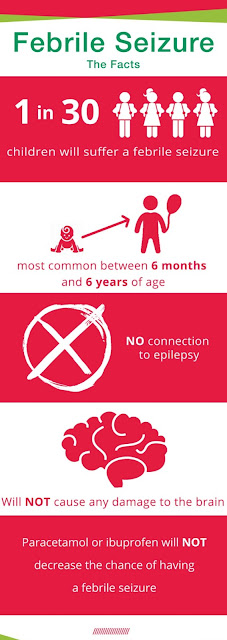Febrile Seizure Overview By Dr Arun Aggarwal Gastroenterologist
 FEBRILE SEIZURE OVERVIEW — Febrile seizures are convulsions that occur in a child who is between six months and five years of age and has a temperature greater than 100.4ºF (38ºC).
FEBRILE SEIZURE OVERVIEW — Febrile seizures are convulsions that occur in a child who is between six months and five years of age and has a temperature greater than 100.4ºF (38ºC).CAUSES OF FEBRILE SEIZURES
Infection — Febrile seizures can occur as a result of the fever that accompanies bacterial or viral infections, especially human herpesvirus-6 (also called roseola or sixth disease).
Immunizations — Fever can occur as a side effect of certain vaccines.
Risk factors — A family history of febrile seizures increases a child's risk of febrile seizures.
FEBRILE SEIZURE SYMPTOMS
Febrile seizures usually occur on the first day of illness, and in some cases, the seizure is the first clue that the child is ill. Most seizures occur when the temperature is higher than 102.2ºF (39ºC).
Febrile seizures are classified as being simple or complex.
Simple — Simple febrile seizures are the most common. Typically, the child loses consciousness and has a convulsion or rhythmic twitching of the arms or legs. Most seizures do not last more than one to two minutes. After the seizure, the child may be confused or sleepy, but does not have arm or leg weakness.
Complex — Complex febrile seizures are less common and can last more than 15 minutes. The child may have temporary weakness of an arm or a leg after the seizure.
FEBRILE SEIZURE EVALUATION AND TREATMENT
According to Dr Arun Aggarwal Gastroenterologist a child who has a febrile seizure should be seen by a pediatrician as soon as possible. Some children, particularly those less than 12 months of age, may require testing to ensure that the fever is not related to meningitis, a serious infection of the lining of the brain.
The best test for meningitis is a lumbar puncture (also known as a spinal tap), which involves inserting a needle into the low back to remove a small amount of fluid (cerebrospinal fluid or CSF) from around the spinal cord.
Treatment for prolonged seizures usually involves giving an antiseizure medication and monitoring the child's heart rate, blood pressure, and breathing. If the seizure stops on its own, antiseizure medication is not required. After the seizure has stopped, treatment for the fever is started, usually by giving oral or rectal acetaminophen or ibuprofen and sometimes by sponging with room temperature (not cold) water.
RECURRENT FEBRILE SEIZURE
Children who have a febrile seizure are at risk for having another febrile seizure; this occurs in approximately 30 to 35 percent of cases. Recurrent febrile seizures do not necessarily occur at the same temperature as the first episode, and do not occur every time the child has a fever. The risk of recurrent febrile seizures is higher for children who:
- Are young (less than 15 months)
- Have frequent fevers
- Have a parent or sibling who had febrile seizures or epilepsy
- Have a short time between the onset of fever and the seizure
- Place the child on their side but do not try to stop their movement or convulsions. Do not put anything in the child's mouth.
- Keep an eye on a clock or watch. Seizures that last for more than five minutes require immediate treatment. One parent should stay with the child while another parent calls for emergency medical assistance.
Preventive treatment
In most cases, treatment to prevent future seizures is not recommended; the risks and potential side effects of daily antiseizure medications outweigh their benefit. Treatment for fever (temperature greater than 100.4ºF or 38ºC) is acceptable.
FOLLOW-UP
Intelligence and other aspects of brain development do not appear to be affected by a febrile seizure, whether the seizure was simple, complex, or recurrent or whether it occurred in the setting of infection or after immunization.

Comments
Post a Comment